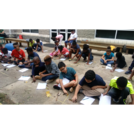
Stellar Parallax Clarification. Created by Sal Khan.
- Subject:
- Astronomy
- Physical Science
- Material Type:
- Lesson
- Provider:
- Khan Academy
- Provider Set:
- Khan Academy
- Author:
- Sal Khan
- Date Added:
- 11/24/2010

Stellar Parallax Clarification. Created by Sal Khan.

Street lights of the same type will look brighter when they are close to you, and less bright when they are farther away. The same applies to astronomical objects: a given star will look brighter to a nearby observer than to an observer far away. In both cases, the difference in brightness can be used to deduce the relative distances of suitable objects. Standard candles, objects of constant intrinsic brightness or whose intrinsic brightness can be determined by careful measurements, are a key tool for astronomical distance determination. In this exploration, you will explore standard candles (and also effects that complicate distance measurements) in a simple everyday setting, namely that of street lights, using a digital camera and freely available software.


Teacher Overview Text

This is a computer lab activity where students view images of stars, nebulas, and galaxies and discover factors in telescope design that allow scientists to study the universe. The students will write questions about the images and produce a power point presentation on features of the universe.

In this video from the Science and Technology Chat series, learn about astrobiology, an interdisciplinary field that uses biology, astronomy, and geology to study the origins of life on Earth and to search for possible life on other planets.

Learn how light plays an important role in what you see and don't see in space. Engage in fun activities learning about light pollution and how the Sun, Earth and Moon interact with one another. Finally we will incorporate the other planets in our solar sytem and learn how they all move about one another in space.

Students investigate three-dimensional objects. They compare what constellations look like when seen from different angles. They make a model of a constellation and look at it from different sides to discover that the relative position of the stars changes depending on our perspective. They understand that stars are not located on the same plane and or the same distance.

White and Black Dwarfs. Created by Sal Khan.

Why Cepheids Pulsate. Created by Sal Khan.